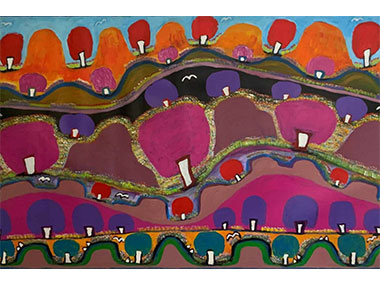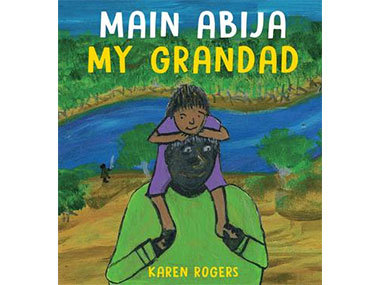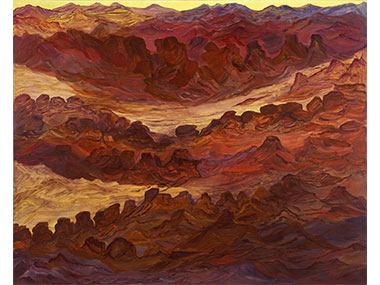Bla Mela Kantri

The colourful Alan Joshua painting that exemplifies the Ngukurr style of painting to be seen in 'Bla Mela Kantri'
Posted by Jeremy Eccles | 22.03.21
Dates:
26.03.21
: 10.05.21
Location: Godinymayin Yijard Rivers Arts and Culture Centre in Katherine, NT
OK – I wonder whether you can make sense of my Kriol title for this story??? For it's the title of an exhibition exploring different representations of landscapes around Ngukurr, the south Arnhemland township where many tribes met beside the Roper River.
Here's a clue – Kantri, of course is Country. So the whole means 'Our Country'. And with that as a very brief clue as to how Kriol works, mixing phonetic spellings of English words with local language, here's the rest of the Ngukurr statement (with translation):
Mela wek im luk la olwan stail en nyuwan stail. Mela luk la kantri en koltja bla mela wek, mikstimapbat olwan en nyuwan.
Our work looks to both new and old styles. Our work looks to country and culture. We mix the old with the new.
Longtaim, loda difrendifren traib bin gaman la ol mishin, bla bi seif burrum ola munanga hu bin kilimbat blakbala. Til didei, mela stil gadim bigmob traib jidanbat la Ropa. Mela Ngalakgan, Alawa, Mangarrayi, Ngandi, Marra, Warndarrang, Nunggubuyu, Ritharrngu-Wägilak en Rembarrnga pipul, en mela gulu mijel Yugul Manggi mijimit.
A long time ago, many different tribes took refuge at the Roper River Mission, fleeing from massacres by pastoralists in the area. Today, we still have many tribes living here at Ngukurr. We are Ngalakgan, Alawa, Mangarrayi, Ngandi, Marra, Warndarrang, Nunggubuyu, Ritharrngu-Wägilak and Rembarrnga people, and together we call ourselves Yugul Manggi.
Yu gin luk dis histri la ola atwek la Ngukurr Arts. Ebirribodi gadim difrendifren stail. Ebirribodi peintim difrendifren ting na. Bat wan ting im seim la ebirribodi stail, im ol brabili braitwan en strongbalawan.
You can see this history in our work at Ngukurr Arts. Our work shows a great diversity of styles and subjects, however our works all have boldness and brightness in common.
Mela olpipul laik Ginger Riley, Gertie Huddlestone, Sambo Barra Barra en Maureen Thomson bin ol feimis bla yusim loda braitwan kala en burdiwan stail bla shoum alabat kantri. Mela stil bulurrum alabat didei la Ngukurr Arts.
Our Elders came before us, including Ginger Riley, Gertie Huddlestone, Sambo Barra Barra and Maureen Thomson. They were all known for using adventurous styles and bright colours to paint their country. We still follow them today at Ngukurr Arts.
Dijan eksibishin im Bla Mela Kantri. Bla mela kantri brabili impotin la mela. Mela kantri im mela laif. Mela peinting ma shoum mela ekspiriens la kantri na.
This exhibition shows Our Country. Our country is exceptionally important to us. Our country is our life country is our life. Our paintings show how we experience our country. country is our life. Our paintings show how we experience our country.
Disma peinting im bla shoum ebirribodi, munanga en blakbala, wi kantri. Bat im rili bla lenim mela biginini mob bla koltja du. Wen mela peintim kantri mela gibit mesij la mela biginini, im dali alabat dat kantri im impotinwan.
These paintings are to show everyone, whitefellas and Aboriginal people, our country. But most importantly it’s to teach our children about culture too. When we paint our country we give our children a message; that country is important. .
And the 'our' in this exhibition are Jill Daniels, Karen Rogers, Betty Roberts, Alan Joshua, and Joyce Huddleston.
Sadly, this first exhibition of Ngukurr art since 'Colour Country' toured in 2009/10, can only be seen at Godinymayin Yijard Rivers Arts and Culture Centre in Katherine, NT from
26 March to 10 May.
But, now you're expert in reading Kriol, I should mention that the exhibition opening will also feature the launch of Ngukurr woman, Karen Rodger’s childrens book, 'Main Abija' – which, of course, you can all translate as 'My Grandad'. It's a delightfully illustrated book (by the author) from Allen & Unwin in which Karen recalls her childhood and the powerful influence her Abija had in teaching her about Country, hunting and fishing, the stockman's life and what the author calls Koltja wei – cultural ways. For Karen Rodgers initiated the project in Kriol and has had help with the translation. A QR code allows you to hear her reading in both languages.
And I tested it out on my four year old grandson, and I can assure you a new respect grew in his eyes as we read! Rogers had some practice too - she lives with her family in Ngukurr and has five children, eight grandkids and one great-grandson.
URL: https://gyracc.org.au/exhibition/bla-mela-kantri-our-counrty/
Share this:
»  del.icio.us
»
del.icio.us
»  Digg it
»
Digg it
»  reddit
»
reddit
»  Google
»
Google
»  StumbleUpon
»
StumbleUpon
»  Technorati
»
Technorati
»  Facebook
Facebook
Contact Details

The cover for Karen Rogers' kids book, 'Main Abija - My Grandad'.

A classic landscape by the late Angelina George from Ngukurr, 'Near Ruined City' (2007)
Further Research
Artists: Alan Joshua | Angelina George | Betty Roberts | Gertie Huddlestone | Ginger Riley | Jill Daniels | Joyce Huddleston | Karen Rogers | Maureen Thomson | Sambo Barra Barra
News Tags: Aboriginal massacres | Allen & Unwin | Godinymayin Yijard Rivers Arts and Culture Centre | Jeremy Eccles | Karen Rogers | Kriol language | Ngukurr | Roper River Mission
News Categories: Australia | Blog | Book | Exhibition | Feature | Industry | News
Exhibition Archive
- 24.03.21 | All Revealed in Freo
- 22.03.21 | Bla Mela Kantri
- 19.03.21 | Two Big Moves
- 16.03.21 | The Very Late Charlie Flannigan
- 08.03.21 | PAPUNYA ART AT 50
- 19.02.21 | National Endowment for Indigenous Visual Arts
- 11.01.21 | "Lost in Another Person's Culture”
- 04.01.21 | Appreciating Mparntwe
- 09.12.20 | Museological Sydney
- 02.12.20 | Getting Back into the Habit in Sydney
- 25.11.20 | VICTORIA OPENS!
- 17.11.20 | Aboriginal Art Storms Online
- 10.11.20 | 'Nilimurra Dhuwal: Here We Are' by Guynbi Ganambarr
- 06.11.20 | GORDON BENNETT SOLO IN QUEENSLAND
- 28.10.20 | The 'Seven Sisters' Heading for England
Advertising

